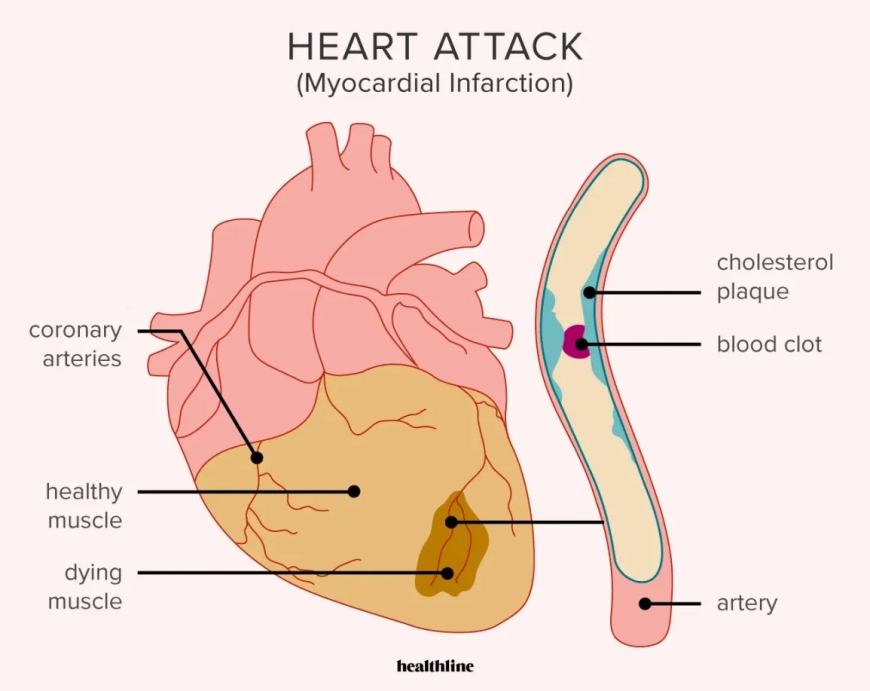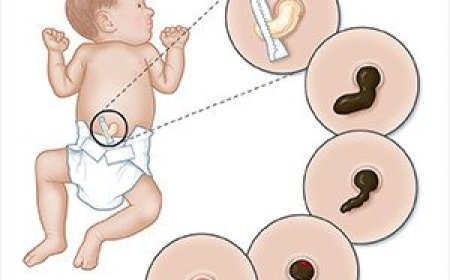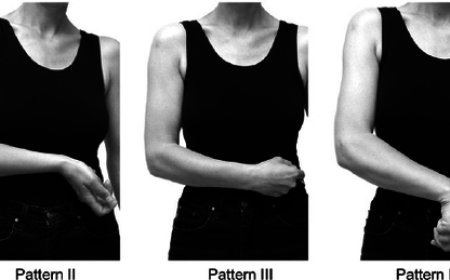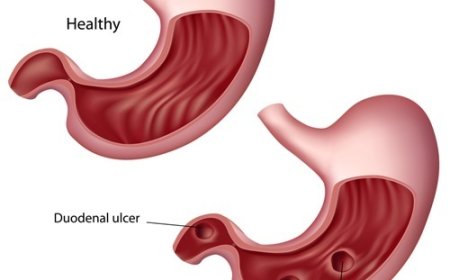Introduction To Heart Attack For Kids

A heart attack, also known as a myocardial infarction, occurs when the blood supply to a part of the heart muscle is blocked, usually due to a blood clot. This blockage prevents oxygen-rich blood from reaching that area of the heart, leading to damage or death of the heart muscle cells.
Imagine your heart as a house with many rooms. These rooms need food and oxygen to stay healthy and do their jobs. Blood brings this food and oxygen to the rooms.
But sometimes, a naughty thing called a "blood clot" blocks the way of the blood. It's like a big wall that stops the food and oxygen from reaching some rooms of the heart.
When the rooms don't get enough food and oxygen, they get hurt, just like when you don't eat healthy food. This can make the heart feel very sick, just like when you're not feeling well.
So, we need to make sure our heart stays happy and healthy by eating good food, exercising, and staying away from bad habits. That way, we can keep those naughty blood clots away and have a strong and happy heart!
The most common cause of a heart attack is a condition called coronary artery disease (CAD), where the coronary arteries that supply blood to the heart become narrowed or blocked due to a buildup of fatty deposits called plaque. Other causes may include a spasm of the coronary artery or a blood clot that forms elsewhere in the body and travels to the coronary arteries.
Imagine your heart as a house that needs a special road to bring it food and oxygen. This road is called a "coronary artery." But sometimes, tiny bits of yucky stuff called "plaque" can stick to the road and make it narrow or blocked.
When the road gets blocked, the heart doesn't get enough food and oxygen, and it becomes sad and sick. This can happen because of the yucky stuff on the road or if a "blood clot" from somewhere else comes and stops the road.
The process of a heart attack typically involves the following steps:
Coronary artery disease (CAD): Most heart attacks are a result of underlying coronary artery disease. CAD occurs when the coronary arteries, which deliver oxygen and nutrients to the heart, become narrowed or blocked due to the buildup of fatty deposits called plaques on the inner walls of the arteries.
Let's explain it using a cartoon example:
Imagine your favorite cartoon character, let's call them Charlie, has a treehouse that they love to play in. Now, the treehouse represents the heart, and the blood vessels are like the roads that bring supplies (oxygen and nutrients) to the treehouse.
In CAD, something called plaque starts to build up inside the blood vessels, like leaves and branches clogging the roads. As more plaque builds up, the roads become narrower, making it harder for the supplies to reach the treehouse (heart).
Over time, if the roads get too narrow or completely blocked by the plaque, the supplies can't get through, and the treehouse doesn't get what it needs to stay strong and healthy.
This can cause problems for Charlie's treehouse (heart). It might not work as well as before, and Charlie might feel tired, have chest pain, or find it difficult to do the activities they enjoy, like playing games or running around.
To help fix the problem, doctors might suggest things like eating healthy foods, exercising, and taking special medicines. In some cases, if the roads are really blocked, doctors might even do a special surgery to create new roads or fix the existing ones.
The important thing for Charlie and anyone with CAD is to take care of the treehouse (heart) by keeping the roads clear and ensuring the supplies can flow smoothly. That way, Charlie can continue having fun and enjoying their adventures in the treehouse!
Plaque rupture: Within the narrowed or blocked coronary artery, one of the plaques may rupture or break open. This triggers a series of events leading to the formation of a blood clot.( Plaque rupture refers to the breaking or tearing of the fatty deposits, known as plaques, that build up on the inner walls of arteries.)
Let's explain it using a cartoon example:
Imagine your favorite cartoon character, let's call them Lily, has a toy castle that they love to play in. Now, inside the castle, there are little blocks that make up the walls.
Sometimes, the blocks can start to break or become weak. That's what happens with plaque inside the blood vessels. Plaque is like tiny blocks made of fat and other stuff that can build up on the walls of the blood vessels.
Sometimes, the plaque can become unstable or weak. It's like when the blocks in Lily's castle start to crumble or fall apart.
When the plaque becomes really unstable, it can suddenly break, just like when a block in the castle wall falls down. When this happens, it can cause trouble.
The broken plaque can create a big bump or a clot inside the blood vessel, almost like a big ball of tangled yarn. This bump can block the blood from flowing smoothly, just like when a big ball of yarn gets stuck in a pipe.
When the blood can't flow well, it can make the heart or other parts of the body feel sick. It can cause chest pain or even more serious problems.
That's why it's important for Lily, and anyone else, to take care of their bodies by eating healthy foods, staying active, and listening to their doctors. Taking care of our bodies helps keep the castle (heart) and its walls (blood vessels) strong and healthy.
Blood clot formation: When a plaque ruptures, the body's clotting factors come into action, causing the formation of a blood clot around the ruptured plaque. The blood clot can partially or completely block the coronary artery, reducing or cutting off blood flow to the heart muscles.
Let's explain it using a cartoon example:
Imagine your favorite cartoon character, let's call them Maya, is on an adventure in a river filled with small boats called red blood cells. These boats carry important supplies like oxygen and nutrients to different parts of the body.
Sometimes, the river can get blocked by obstacles. In this case, let's imagine there are little creatures called platelets that live in the river.
When Maya accidentally gets a cut or scrape, the platelets come to the rescue. They quickly gather around the injured area, like a superhero team assembling, to help stop the bleeding.
The platelets stick together like puzzle pieces, forming a strong shield around the wound. It's like they're building a wall to protect Maya from further harm.
But sometimes, even when there is no injury, the platelets can get confused and think there is a problem. They start to stick together and form a clot, like a big traffic jam of boats in the river.
This blood clot can be a problem because it can block the flow of the river, just like when a bunch of boats get stuck together. It can prevent the red blood cells from delivering their important supplies to other parts of the body.
When a blood clot forms, it can cause swelling and pain, just like when a river overflows and floods the nearby land. It's important for Maya, and anyone else, to stay healthy by eating well, staying active, and taking care of their bodies to help prevent blood clots from forming in places where they shouldn't.
Ischemia: The blockage of the coronary artery prevents oxygen-rich blood from reaching a part of the heart muscle. This lack of oxygen, known as ischemia, can lead to injury or death of the heart muscle cells.(Ischemia refers to a reduced or inadequate blood supply to a part of the body, typically due to a blocked or narrowed blood vessel.)
Let's explain it using a cartoon example:
Imagine your favorite cartoon character, let's call them Max, is a superhero who needs a lot of energy to fly around and save the day. Max's superpower comes from a special power source called oxygen, which is carried by tiny vehicles called red blood cells.
Now, let's say Max is flying through a city and suddenly comes across a roadblock. The roadblock represents a blocked or narrow blood vessel in the body.
When the road is blocked, the vehicles carrying oxygen, the red blood cells, can't pass through to reach the buildings and give them the energy they need. The buildings represent the organs or body parts in our body.
Without the oxygen from the red blood cells, the organs or body parts don't get the energy they require to work properly. It's like the buildings can't function without electricity.
This lack of energy causes the organs or body parts to feel tired, weak, or even start to have problems. For example, if the heart doesn't get enough oxygen and energy, it may start to hurt or feel uncomfortable.
Ischemia is when the organs or body parts don't get enough oxygen and energy because of a roadblock in the blood vessels. It's important for Max, and anyone else, to keep their blood vessels healthy by eating nutritious foods, staying active, and taking care of their bodies to ensure the red blood cells can deliver oxygen and energy to all the important places.
Infarction: If the blood flow is not restored quickly, the affected part of the heart muscle may die, resulting in a myocardial infarction or heart attack.(Infarction refers to the death or damage of tissue or cells in a particular part of the body.)
Let's explain it using a cartoon example:
Imagine your favorite cartoon character, let's call them Mia, has a beautiful garden with lots of flowers. The flowers represent the cells in our body that need oxygen and nutrients to stay healthy and alive.
Now, let's say Mia accidentally forgets to water one section of her garden for a long time. As a result, the flowers in that area don't get the water they need to survive.
Over time, without enough water, the flowers in that section of the garden start to wither and die. This is similar to what happens in our body when cells don't get enough oxygen and nutrients.
In our body, there are tiny blood vessels called capillaries that carry oxygen and nutrients to the cells. But sometimes, these blood vessels can get blocked or completely closed off, just like when something blocks the flow of water to Mia's garden.
When a blood vessel gets blocked, the cells that rely on that blood vessel for oxygen and nutrients don't receive them anymore. Without the necessary oxygen and nutrients, the cells begin to die, just like the flowers in Mia's garden that didn't receive water.
This process of cell death due to a lack of oxygen and nutrients is called infarction. It can happen in different parts of the body, like the heart, brain, or other organs when their blood supply is blocked.
Infarction can cause serious problems and make Mia or anyone else feel sick or in pain. That's why it's important to take care of our bodies by eating healthy, staying active, and seeking medical help if we feel unwell.
Consequences: The severity and extent of the heart attack depend on factors such as the location of the blockage, the size of the affected area, and the duration of the blockage. Complications can include irregular heart rhythms, heart failure, and damage to the heart's pumping function.
Heart Attacks in India:-
According to the Indian Heart Health Association, men under the age of 50 account for 50% of all heart attacks in India, while men under the age of 40 account for 25%. Men are slightly more prone to cardiovascular problems than women are.
According to a WHO research, India is responsible for roughly 1/5 of the 17.9 million heart attack fatalities worldwide!
The study added that a total of 62% of the individuals in their close network who were suffering from such serious diseases had received two doses of vaccination; 11% had only received one dose, and 8% had not.
It's interesting to note that while 28% of respondents claimed their contacts with such severe problems did not have Covid, 61% of those in their immediate network who had such conditions had experienced Covid once or more.
Factors which causes heart attack in India:-
- Not eating healthy food and not exercising can make the heart weak.
- Smoking or using tobacco hurts the heart and can cause problems.
- Some people have conditions like high blood pressure or diabetes that can lead to heart attacks.
- Some people have genes that make them more likely to have heart problems.
- Breathing polluted air can also be bad for the heart.
- If people don't have enough money for good healthcare, it can be harder to take care of their hearts.
- Feeling very stressed or sad can also affect the heart.
- In cities, people are eating more unhealthy foods and not moving enough, which can hurt their hearts too.
Treatments for heart attack:-
- Medicines: They give special medicines to help the heart, like aspirin to prevent more clots, and nitroglycerin to ease chest pain.
- Balloon and Stent: Doctors may use a small balloon and a tube (catheter) to open the blocked blood vessel and put a tiny tube called a stent to keep it open.
- Bypass Surgery: If many blood vessels are blocked, they may do a special surgery where they use a healthy blood vessel to create a new path for the blood to flow around the blockages.
- Exercise and Education: After the heart attack, they help the person exercise and teach them how to stay healthy, so their heart stays strong.
Examples of Indian celebrities or public figures who have had heart attacks:
- Dilip Kumar: Famous actor, had a heart problem in 2013.
- Manohar Parrikar: Politician, had a heart problem in 2018.
- Arun Jaitley: Politician, had a heart problem in 2019 and later passed away.
- Rajesh Khanna: Famous actor, had a heart problem in 2012.
When Indian celebrities or public figures experience a heart attack, they typically receive immediate medical attention from a team of healthcare professionals, including heart specialists or cardiologists. The exact care and treatment provided may vary based on the severity of the heart attack and individual patient needs. Here's an overview of how Indian celebrities or public figures may be taken care of by heart specialists during a heart attack.
- Quick Help: When a heart attack happens, an ambulance takes them to a hospital with heart experts right away.
- Tests: The doctors do tests like checking the heart's electricity, blood tests, and pictures of the heart to see what's wrong.
- Fixing the Blockage: If needed, the doctors use special tools to open the blocked blood vessels and help the heart get enough blood.
- Medicines: They also give special medicines to help the heart get better and prevent more problems.
- Special Care: After the heart attack, the person stays in the hospital for extra care. They might join a special program to exercise and learn how to stay healthy.
Famous people get extra attention and care, but all hearts are important, and everyone should take good care of their hearts too.
Symptoms of heart attack:-
- Chest Pain: Most common symptom, feels like pressure or squeezing in the chest.
- Arm or Neck Pain: Pain in the arms, neck, jaw, or back can also happen.
- Trouble Breathing: Feeling out of breath or having difficulty breathing.
- Sweating: Sudden and unexplained sweating, like a cold sweat.
- Feeling Sick: Some may feel nauseous or might vomit.
- Feeling Dizzy: Feeling like you might faint or feeling lightheaded.
- Tiredness: Unusual tiredness or feeling really tired.
Precautions for heart attack:-
- Eat Good Food: Eat lots of fruits, veggies, and healthy foods. Avoid too much junk food and salty snacks.
- Play and Move: Play games and exercise regularly. Running, cycling, or swimming are fun ways to stay active.
- No Smoking: Don't smoke or be near others who smoke. It's bad for your heart.
- Stay at a Healthy Weight: Try to keep your body at a good weight by eating healthy and exercising.
- Check Your Blood Pressure: Ask a grownup to check your blood pressure sometimes. It helps to keep it in a healthy range.
- Watch Your Cholesterol: Avoid fatty foods. Check with your doctor if you need help.
- Be Careful with Sugar: Don't eat too many sugary things like cookies and soda.
- Manage Stress: Find ways to relax and stay happy. Playing with friends or doing hobbies can help.
- Limit Alcohol: If you're a grownup, don't drink too much alcohol. It's not good for the heart.
- See the Doctor: Visit the doctor regularly for check-ups. They can help you stay healthy and happy!
What's Your Reaction?
 Like
0
Like
0
 Dislike
0
Dislike
0
 Love
0
Love
0
 Funny
0
Funny
0
 Angry
0
Angry
0
 Sad
0
Sad
0
 Wow
0
Wow
0






































































